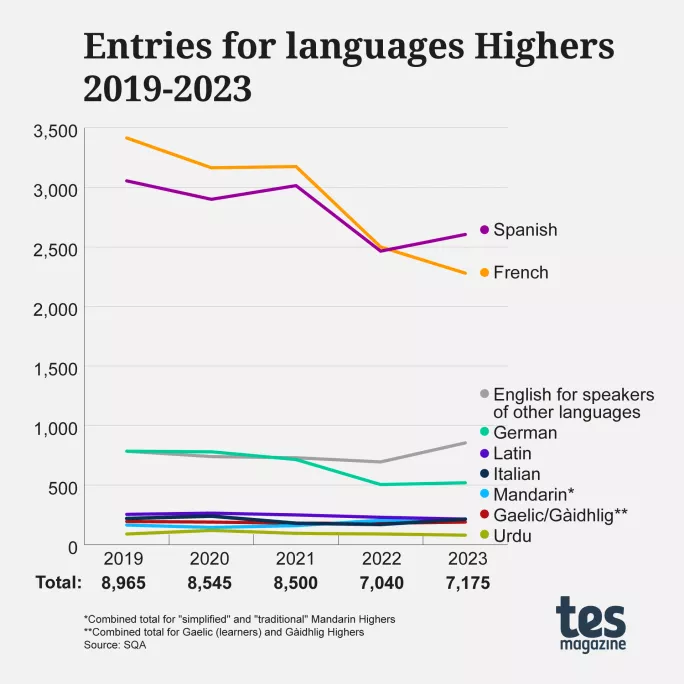Oh là là - concerns over uptake of languages Highers

New Scottish national data shows a drop in uptake of languages at Higher since 2019, the last year before the Covid pandemic.
The decrease in French entries is particularly steep and, after many years as the most popular language in Scottish schools, uptake is now lower than for Spanish.
However, Scotland’s National Centre for Languages (widely known as SCILT) says there is better news in National 5 figures, which suggest there may be the beginnings of a comeback from the Covid years.
Out of 191,810 total Higher entries across all subjects in 2023, nine languages (see graph) made up 3.7 per cent of all entries (7,175).
In 2019 there were 185,915 total Higher entries and the same nine languages made up 4.8 per cent of all entries (8,965).

Higher French entries are down by a third since 2019 (when there were 3,415) to this year’s tally of 2,280. Significantly, French has fallen below Spanish after long being the most popular language at Higher. However, the 2,605 Higher Spanish entries for 2023 are also below the 2019 figure (3,055), although up marginally on 2022 (2,465).
Meanwhile, the long decline of German - in the decades since it and French were by far the two most popular languages in Scottish schools - has had a small measure of respite, with 520 entries marking a slight rise from 2022 (505), although still significantly down on 2019 (785).
Decline in Higher entries for European languages
The combined entries for the four European languages of Spanish, French, German and Italian have decreased every year since the 7,475 in recorded in 2019, with 5,620 entries in 2023.
Only two of the nine languages analysed by Tes Scotland show more entries in 2023 than 2019: Mandarin (when combining the “traditional” and “simplified” Highers) has 215 this year (160 in 2019) and English for speakers of other languages has 855 this year (785 in 2019).
- Context: SQA results 2023
- Related: “Most adults” should be able to speak a foreign language
- Languages in schools: How we’re trying to win hearts and minds
- Q&A: 10 questions with... Fhiona Mackay
- Research: Secondaries failing to deliver “right” to languages
- In England: Tackling the decline in languages in state schools
At National 5, French entries have dropped by more than 1,000 from 7,870 in 2019 to 6,820 in 2023, although this is more than in 2022 (6,630). Spanish National 5 entries have fluctuated since 2019 (5,120) but this year marks a new high in that period (5,900).
At Advanced Higher, 2023 entries for both French (450) and Spanish (400) are down on 2019 (605 and 470 respectively).
SCILT director Fhiona Mackay said the drop in Higher languages entries was “completely expected given the drop in Nat 5 entries last year” and that “we feel it can be attributed to a legacy from the pandemic years, when it was particularly difficult to sustain language learning”.
However, she added that “there may be some encouragement in this year’s Nat 5 uptake across languages”.
SCILT depute director Lisa Hanna said: ”I think we cannot underestimate the impact the pandemic has had specifically on languages...learners need that teacher contact to feel confident when learning to communicate in another language, and I believe that these numbers reflect the fact that learners are feeling that absence of contact.
“They are subsequently anxious about choosing languages as there is more perceived risk that exam outcomes may not be as positive as they would like. I’m hopeful that a return to uninterrupted learning will go some way to addressing this, and that in turn we will see a positive change in uptake.”
She stressed that “for those who do choose to study languages, attainment continues to be high”, adding: “I believe that our highly skilled and dedicated language teaching community must be credited for this, and that this is the foundation on which we can continue to build.”
Since 2013 the Scottish government’s “1+2” policy has set out that children should learn two languages in school, starting their first language in P1 and their second in P5, and continuing with them until at least the third year of secondary.
However, government data published in 2022 suggested there was still much progress to be made with 1+2. Based on a survey of 86 per cent of Scottish primary schools and 88 per cent of secondaries, just 69 per cent of primaries were delivering a second language continuously from P1-7.
Register with Tes and you can read two free articles every month plus you'll have access to our range of award-winning newsletters.
Keep reading with our special offer!
You’ve reached your limit of free articles this month.
- Unlimited access to all Tes magazine content
- Save your favourite articles and gift them to your colleagues
- Exclusive subscriber-only stories
- Over 200,000 archived articles
- Unlimited access to all Tes magazine content
- Save your favourite articles and gift them to your colleagues
- Exclusive subscriber-only stories
- Over 200,000 archived articles
topics in this article



